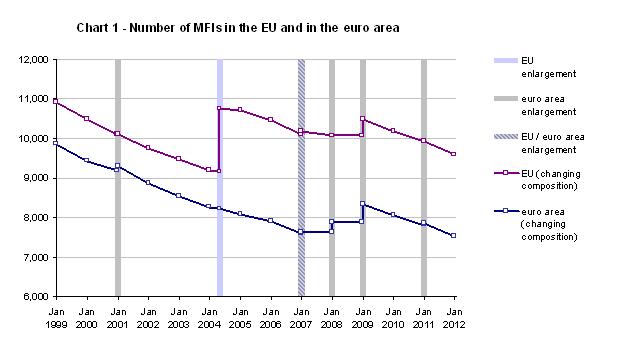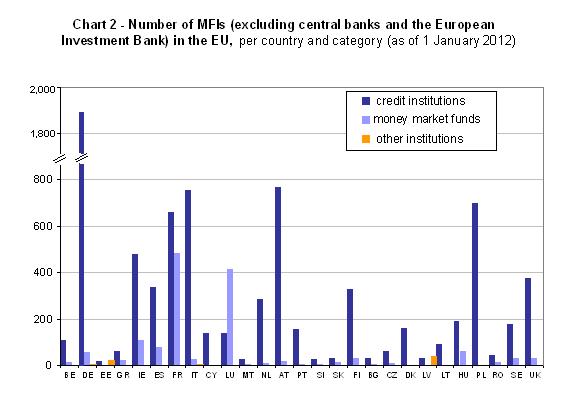The number of monetary financial institutions in the euro area and in the EU decreased further in 2011
On 1 January 2012 the total number of monetary financial institutions (MFIs) [1] in the euro area stood at 7,533. This is a net decrease of 332 units (4%) in comparison with the situation a year ago. With a few minor exceptions, the decline was spread across the whole of the euro area. There were 9,587 MFIs in the European Union (EU) as a whole, a net decrease of 334 units.
Number of MFIs
- On 1 January 2012 there were 7,533 MFIs resident in the euro area, compared with 7,865 on 1 January 2011. In relative terms, the decrease was particularly pronounced in Ireland (-15%), Luxembourg (-8%), Cyprus (-6%), France (-5%) and Greece (-5%). In absolute terms, Ireland (-106), France (-59), Luxembourg (-48) and Germany (-43) were the main contributors to the net decrease of 332 units in the euro area.
- 2011 saw a substantial decrease in the number of money market funds, as an MFI sub-sector, owing in part to their new definition, under Guideline ECB/2011/13, which is more closely in line with that used for supervisory purposes. The contraction in this sub-sector was most prominent in Ireland (-97), Luxembourg (-46) and France (-29).
- Despite the enlargement of the euro area through the accession of Greece (2001), Slovenia (2007), Cyprus and Malta (both 2008), Slovakia (2009) and Estonia (2011), the number of MFIs in the euro area has decreased by 24% or 2,323 institutions since 1 January 1999. On 1 January 2012 Germany and France accounted for 41% of all euro area MFIs, a share slightly greater than that recorded on 1 January 2011.
- On 1 January 2012 there were 9,587 MFIs resident in the EU, a net decrease of 334 units (-3%) since 1 January 2011. Compared with the situation on 1 January 1999 (10,909 MFIs in the EU), there has been a net decrease of 1,322 units (-12%), despite the addition of 1,608 MFIs on 1 May 2004, when ten new Member States acceded, and of a further 72 MFIs on 1 January 2007, when Bulgaria and Romania joined the EU.

Note: The reduction in the number of MFIs during 2011 largely resulted from the introduction of a common definition for European money market funds (Guideline ECB/2011/13), which led to the reclassification of certain funds formerly recognised as money market funds.
Structure of the MFI population
- The vast majority of euro area MFIs are credit institutions (i.e. commercial banks, savings banks, post office banks, credit unions, etc.), which accounted for 82.4% of MFIs (6,210 units) on 1 January 2012, while money market funds represented 16.9% (1,275 units). Central banks (18 units including the ECB) and other institutions (30 units) together accounted for only 0.4% of the total number of euro area MFIs.
- In the EU as a whole, credit institutions accounted for 84% of MFIs on 1 January 2012, while money market funds represented 15% (see Chart 2 below).

Country breakdown on 1 January 2012
- In the euro area, Germany and France accounted for 41.2% of all MFIs. Italy, Austria, Ireland and Luxembourg accounted for a further 36%. Over the past 13 years (1999-2012) noteworthy developments in national MFI sectors included a significant increase of 494 units in Ireland over the period as a whole. [2] At the same time there were relatively large falls of 55%, 41% and 40% respectively in the number of monetary financial institutions in the Netherlands, France and Germany and lesser declines of 32%, 30%, 22% and 20% in Spain, Portugal, Greece and Belgium (see Table 1 below).
- Among the non-euro area EU Member States, Poland had the largest number of MFIs (703), representing 7% of the MFI sector in the EU, or 34% of MFIs in the non-euro area EU Member States. The United Kingdom (20%), Hungary (12%), Sweden (10%) and Denmark (8%) follow as main contributors to the number of MFIs in the non-euro area EU Member States. Between the beginning of 1999 and 1 January 2012, there was a considerable reduction in the number of MFIs in the United Kingdom and Denmark, by 27% and 24% respectively.
Foreign branches
- On 1 January 2012 638 branches of non-domestic credit institutions were resident in the euro area. These branches accounted for 10% of all euro area credit institutions. 109 of these branches (17%) were located in Germany. Estonia, Belgium, Slovakia and Greece had the largest proportion of foreign branches in relation to the total number of credit institutions, at 59%, 56%, 55% and 41% respectively. The head offices of the majority of the foreign branches in euro area countries were located either in another euro area country (64%) or in the United Kingdom (15%).
- On 1 January 2012 there were 260 branches of foreign credit institutions resident in non-euro area EU Member States. Of these, by far the largest proportion (51%) was located in the United Kingdom. The head offices of the majority of the foreign branches in non-euro area EU Member States were located either in euro area countries (53%) or in other EU Member States (19%).
| Country | Number of MFIs | Percentage changes | |||||||
|---|---|---|---|---|---|---|---|---|---|
| 1 Jan. 1999 | 1 Jan. 2001 | 1 May 2004 | 1 Jan. 2010 | 1 Jan. 2011 | 1 Jan. 2012 | 1 Jan. 1999 to 1 Jan. 2012 | 1 May 2004 to 1 Jan. 2012 | 1 Jan. 2011 to 1 Jan. 2012 | |
| ECB | 1 | 1 | 1 | 1 | 1 | 1 | - | - | - |
| EIB* | - | - | - | 1 | 1 | 1 | - | - | - |
| BE | 153 | 142 | 126 | 121 | 123 | 122 | -20.3 | -3.2 | 0.8 |
| DE | 3,280 | 2,782 | 2,268 | 2,018 | 1,999 | 1,956 | -40.4 | -13.8 | -2.2 |
| EE | - | - | 25 | 38 | 37 | 37 | - | 48.0 | - |
| GR | 102 | 105 | 100 | 89 | 83 | 79 | -22.5 | -21.0 | -4.8 |
| IE | 96 | 211 | 294 | 727 | 696 | 590 | 514.6 | 100.7 | -15.2 |
| ES | 608 | 571 | 512 | 427 | 413 | 415 | -31.7 | -18.9 | 0.5 |
| FR | 1,938 | 1,764 | 1,577 | 1,298 | 1,206 | 1,147 | -40.8 | -27.3 | -4.9 |
| IT | 944 | 884 | 854 | 833 | 808 | 785 | -16.8 | -8.1 | -2.8 |
| CY | - | - | 409 | 156 | 153 | 143 | - | -65.0 | -6.5 |
| LU | 676 | 662 | 586 | 630 | 602 | 554 | -18.0 | -5.5 | -8.0 |
| MT | - | - | 17 | 29 | 32 | 33 | - | 94.1 | 3.1 |
| NL | 668 | 620 | 484 | 305 | 300 | 297 | -55.5 | -38.6 | -1.0 |
| AT | 910 | 866 | 827 | 821 | 806 | 783 | -14.0 | -5.3 | -2.9 |
| PT | 228 | 223 | 205 | 169 | 164 | 159 | -30.3 | -22.4 | -3.0 |
| SI | - | - | 27 | 28 | 28 | 29 | - | 7.4 | 3.6 |
| SK | - | - | 28 | 40 | 43 | 44 | - | 57.1 | 2.3 |
| FI | 354 | 362 | 396 | 383 | 370 | 358 | 1.1 | -9.6 | -3.2 |
| Euro area** | 9,856 | 9,193 | 8,230 | 8,076 | 7,865 | 7,533 | -23.6 | -8.5 | -4.2 |
| BG | - | - | 36 | 36 | 37 | - | - | 2.8 | |
| CZ | - | - | 79 | 68 | 67 | 67 | - | -15.2 | - |
| DK | 216 | 213 | 206 | 167 | 164 | 164 | -24.1 | -20.4 | - |
| LV | - | - | 52 | 74 | 76 | 72 | - | 38.5 | -5.3 |
| LT | - | - | 74 | 88 | 90 | 95 | - | 28.4 | 5.6 |
| HU | - | - | 238 | 246 | 246 | 251 | - | 5.5 | 2.0 |
| PL | - | - | 659 | 714 | 710 | 703 | - | 6.7 | -1.0 |
| RO | - | - | 51 | 55 | 55 | - | - | - | |
| SE | 179 | 177 | 255 | 212 | 205 | 205 | 14.5 | -19.6 | - |
| UK | 556 | 541 | 457 | 422 | 407 | 405 | -27.2 | -11.4 | -0.5 |
| EU** | 10,909 | 10,124 | 10,756 | 10,192 | 9,921 | 9,587 | -12.1 | -10.9 | -3.4 |
* For the purposes of the ECB’s monetary and other euro area statistics, the European Investment Bank (EIB) continues to be treated as an institution that is resident outside the euro area.
** Changing composition
Notes:
The number of MFIs has been derived from the ECB’s “List of monetary financial institutions”, which is updated daily on the ECB’s website and is compiled in such a way as to ensure its completeness, accuracy and homogeneity across countries. Its objectives are twofold, namely (i) to serve as the reference reporting population for the compilation of comprehensive and consistent monetary statistics for the euro area and (ii) to serve as a register and a reliable sampling frame for other data collections and for statistical and economic analyses.
Information on MFIs and other financial institutions, including the list of monetary financial institutions and institutions subject to minimum reserves, can be found on the ECB’s website.
-
[1]“Monetary financial institutions” (MFIs) are central banks, resident credit institutions as defined in Community law, and other resident financial institutions whose business is to receive deposits and/or close substitutes for deposits from entities other than MFIs and, for their own account (at least in economic terms), to grant credits and/or make investments in securities. Money market funds are also classified as MFIs.
-
[2]The overall increase includes 419 units which resulted from the reclassification of Irish credit unions as credit institutions as of 1 January 2009.
Evropská centrální banka
Generální ředitelství pro komunikaci
- Sonnemannstrasse 20
- 60314 Frankfurt am Main, Německo
- +49 69 1344 7455
- media@ecb.europa.eu
Reprodukce je povolena pouze s uvedením zdroje.
Kontakty pro média

